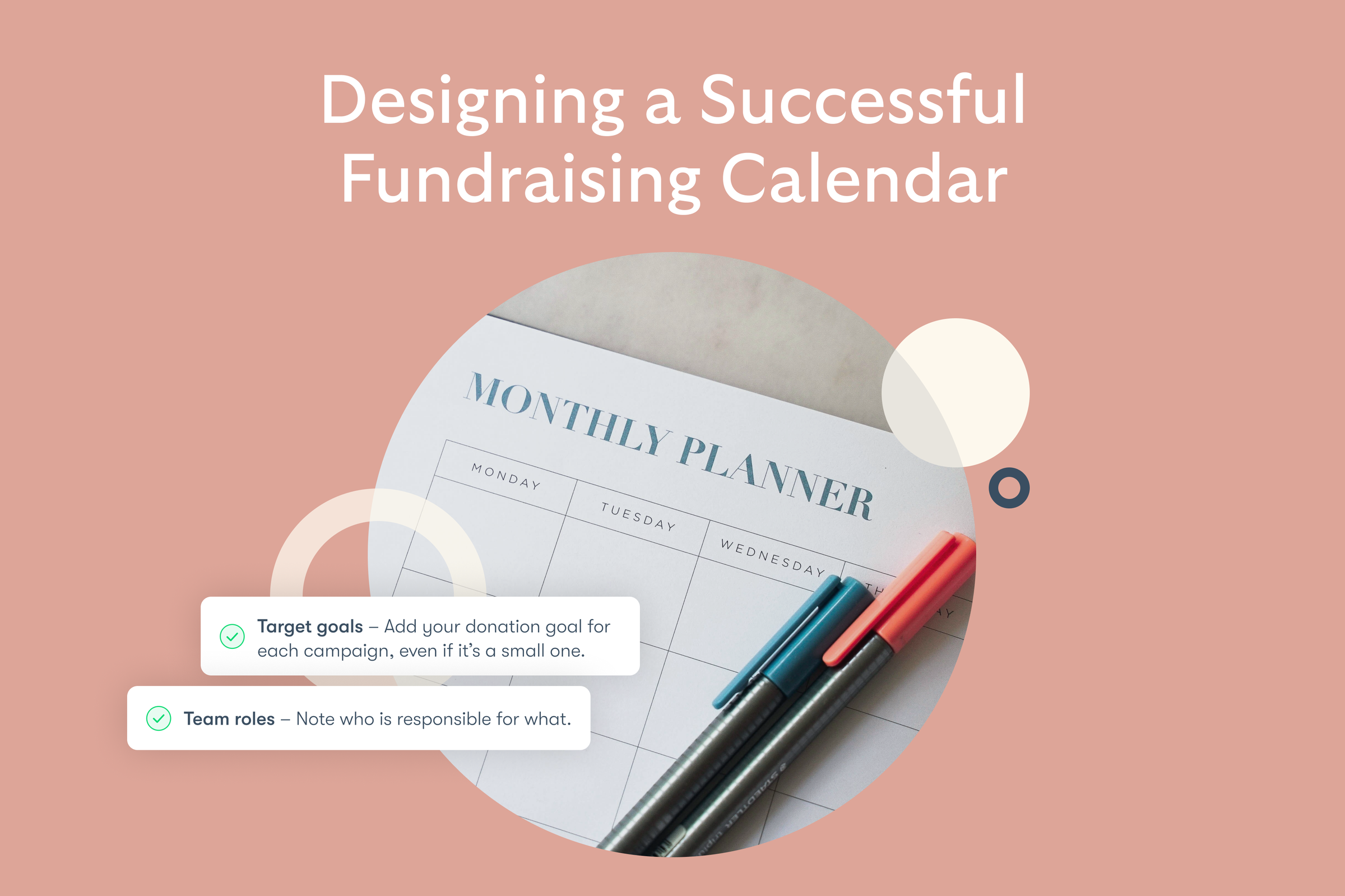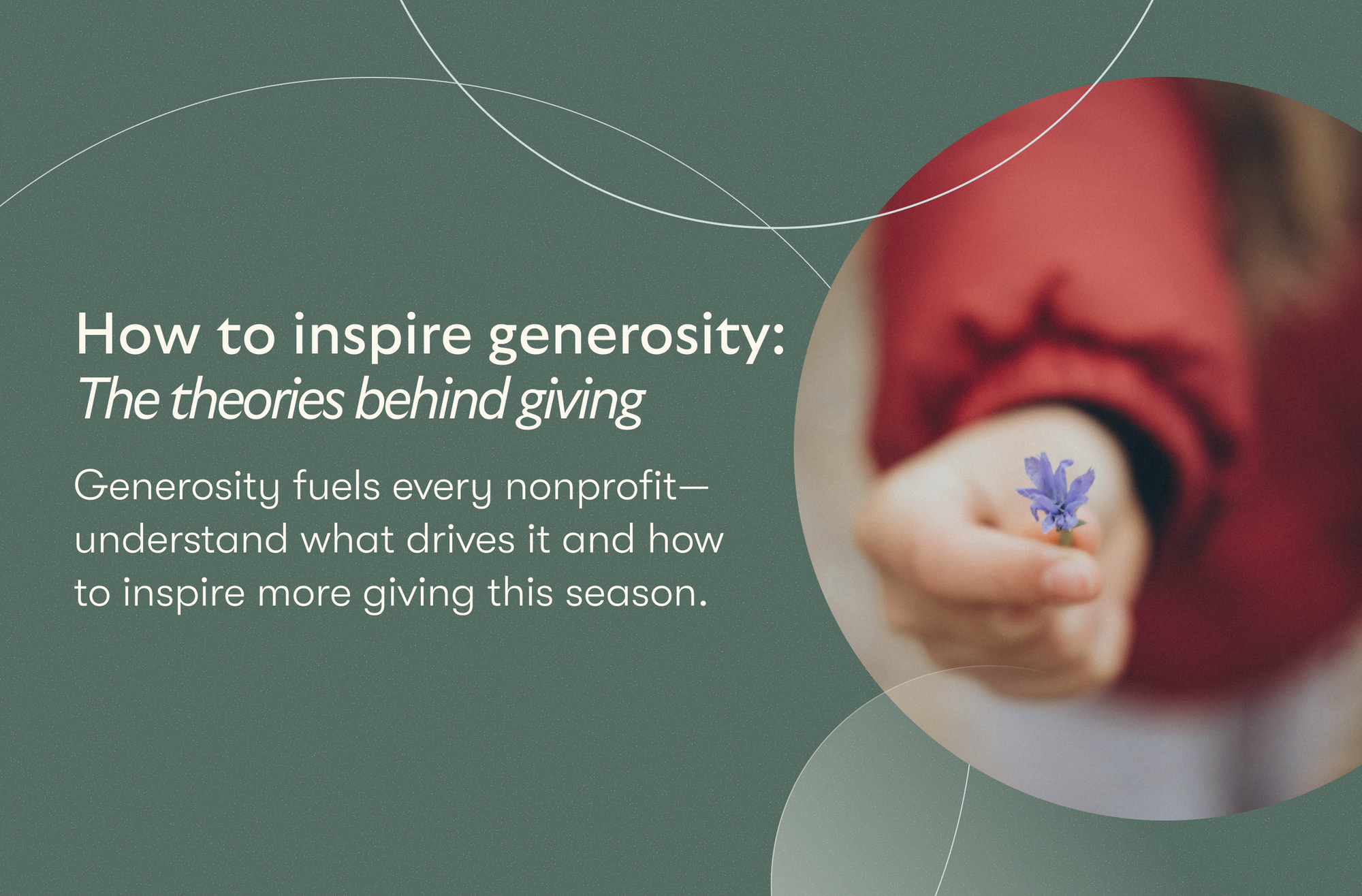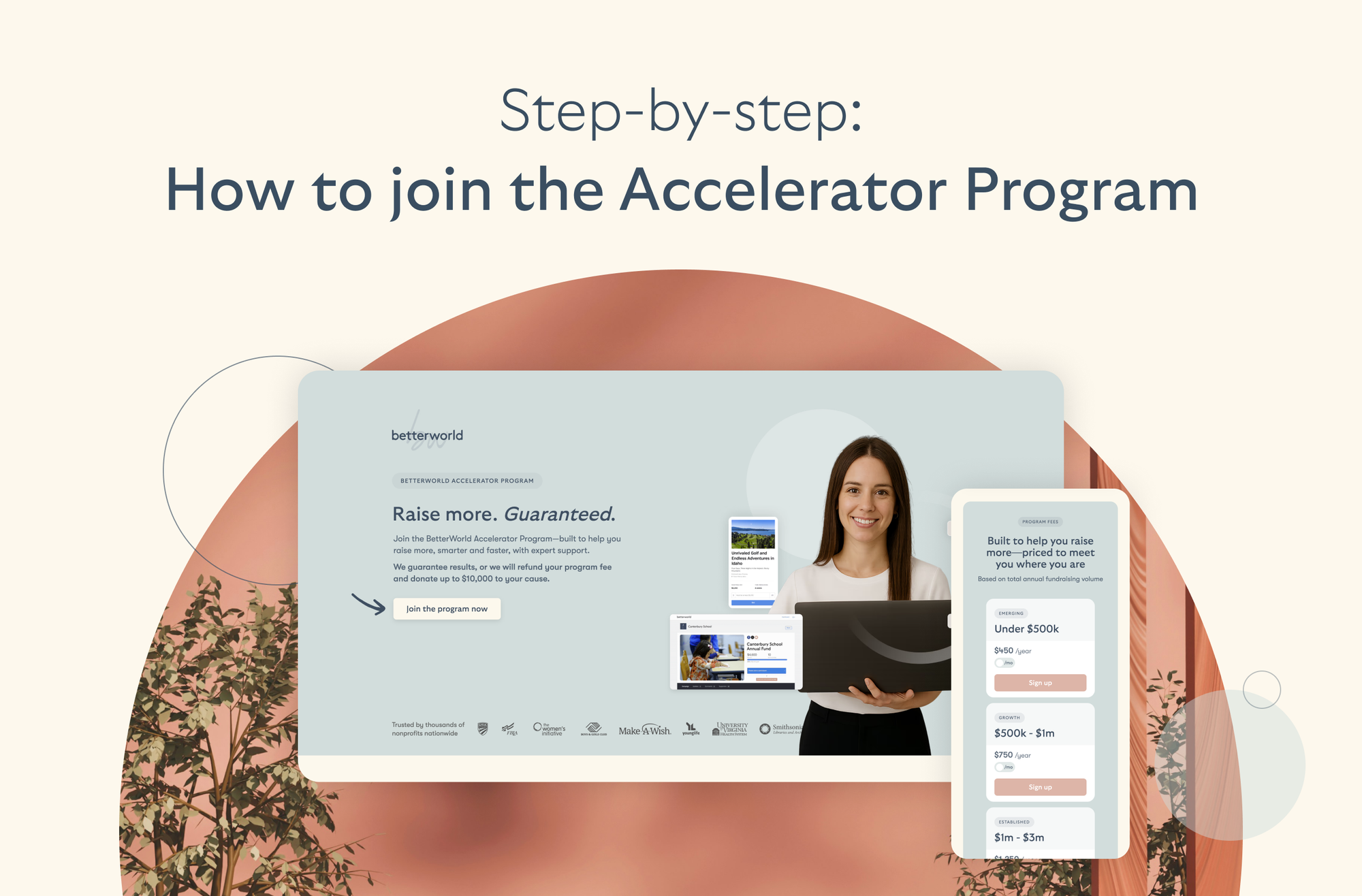Video Integration — boost the buzz around your online fundraising campaign
Time-saving – thoughtful automations save dozens of hours over your campaign
One-Click Checkout — our system will automatically charge the lucky winner
Text Message Notifications — keep your bidders engaged with text message notifications
Designing A Successful Fundraising Calendar
By Whit Hunter

A successful fundraiser rarely happens by chance. It begins with thoughtful planning. If your nonprofit often finds itself scrambling or stressed when organizing events, it might be time to consider a fundraising calendar.
A calendar fundraiser template offers a clear, year-at-a-glance view of your plans. It allows you to strategically space out your fundraising efforts, avoid scheduling conflicts, and keep your team aligned and organized. With this simple yet powerful tool, your nonprofit can ensure events don't overlap with busy seasons so you can make the most out of your fundraising efforts!
In this guide, we’ll walk through how to create an effective calendar fundraiser template that works well and helps you raise money without feeling overwhelmed or rushed.
What is a Fundraising Calendar?
A fundraising calendar is a strategic tool that helps you plan your fundraising events, campaigns, and key dates throughout the year. It’s your nonprofit’s big-picture guide for when to launch donation drives, host events, send emails, or post on social media.
Whether you're using a digital spreadsheet, a printed wall calendar, or an annual fundraising calendar template, the goal is the same: to keep your team aligned and your efforts well-timed. It’s especially helpful when you’re working with volunteers or board members, making sure everyone is on the same page.
How It Helps with Donor Engagement, Communications, and Campaign Execution
A good calendar does more than keep your team organized; it also strengthens your connection with donors. When you plan ahead, you’re more likely to stay consistent, which means donors get regular updates, reminders, and thank-you notes instead of last-minute messages.
It also helps you avoid donor fatigue. Spacing out campaigns leaves room for storytelling, impact updates, and thank you notes, ensuring every touchpoint isn’t just another ask. You don’t want to run back-to-back campaigns that overwhelm people. And when it’s time to launch a campaign, you’re not scrambling. Your team knows what messaging is going out, who’s doing it, and when. Execution is smooth.
What Details Should Be Included in a Well-Structured Fundraising Calendar
You don’t need to make it fancy, but there are a few important things to include:
- Dates – Add key events, deadlines, and campaign launch days.
- Type of campaign – Label what kind of fundraiser it is: online auction, Giving Tuesday drive, peer-to-peer campaign, etc.
- Communication plan – Include when and how you’ll talk to your audience (email, social media, mailers).
- Team roles – Note who is responsible for what.
- Target goals – Add your donation goal for each campaign, even if it’s a small one.
- Follow-ups – Plan ahead for thank-you emails or donor updates after the fundraiser ends.
Find out Why Budgeting Is Important For Nonprofits.
When Should Nonprofits Create a Fundraising Calendar?
The best time to build your fundraising calendar is before the new year or new fiscal year starts. Don’t wait until things get busy. A little early planning can save you a lot of stress later.
Some nonprofits work on a calendar year (January to December), while others use a fiscal year (like July to June). It’s a good idea to match your fundraising calendar with how you plan your budget. That way, your fundraising goals line up with your spending plans.
Start by planning a few months before your year begins. That gives you time to look back at what worked last year and what didn’t. Then, you can pick the best times to run campaigns, host events, or try new things.
Having a plan early also helps avoid last-minute rushes. You won’t be scrambling to find volunteers or get flyers made the week before an event. Plus, donors will hear from you regularly, not just when you're in a hurry.
To keep things easy, try using a free fundraising calendar template. It helps you map out dates, goals, and action steps in one place so everyone on your team can follow along.
How to Create an Annual Fundraising Calendar
A good calendar helps your nonprofit stay organized, reach your goals, and reduce last-minute stress. Here’s how to build one that works for your team.
1. Set Clear Goals and Objectives
Before you pick any dates, understand what you’re trying to achieve. How much do you need to raise? What will the money support? Align your budget needs with your nonprofit’s mission and goals.
Review last year’s numbers. If you raised $15,000 through three events, you might aim for a similar or slightly higher goal this year. Setting targets based on past results helps you plan smarter.
Also, keep an eye on giving trends. For example, if donations drop during summer or increase during the holidays, align your big campaigns with these trends. Local events or changes in the economy can also affect how people give.
Assess Past Fundraising Activities
It’s a good idea to review what has worked in the past and what hasn’t. Which fundraisers brought in the most donations? Which ones got little response? Look at the timing, the type of campaign, and how you shared it with your audience.
Go deeper by checking donor data. How many people gave? Did they come back and donate again? Feedback from donors, volunteers, and staff can also help you figure out what worked well and what needs to change.
Once you have this information, you can start plugging dates and details into a calendar fundraiser template.
2. Identify Key Fundraising Activities
After setting your goals, the next step is to pick the right activities to help you achieve them. You don’t need to do everything, but you do want a good mix.
List your main fundraising efforts. These can include online donation drives, in-person events, mail campaigns, or peer-to-peer fundraising. Also include donor appreciation touches like thank-you calls or updates—they’re just as important to include in your calendar.
Plan seasonally. Consider what works best at different times of the year. A back-to-school supply drive works well in August or September, while a calendar raffle fundraiser template works better in the fall or winter. Giving Tuesday, which happens in late November, is a good time for a short online push. You can also plan a summer walk-a-thon or a spring auction.
Reserve space for your anchor events. If you have a yearly gala, golf tournament, or community dinner, block those dates off early. Seasonal fundraisers, like Valentine’s Day candy sales or holiday gift baskets, can help fill in the gaps.
Try not to rely on just one type of fundraiser. Mixing it up with different activities spreads out your risk. If one campaign underperforms, others can help balance the outcome. This kind of variety also keeps your supporters interested and coming back.
3. Determine Timing and Scheduling
Once you’ve picked your fundraising activities, decide the right time to run each one. Spread your campaigns and events out across the year to prevent burnout for both your team and donors.
Start by assigning dates for each fundraiser. Factor in how long each campaign will take, including time for planning, promotion, and follow-up. A calendar fundraiser template can help you move things around and see how everything fits together.
Be strategic about timing. November and December are prime for donation drives, while warmer months are ideal for outdoor events like walk-a-thons or car washes. Use quieter months, like January or July, for smaller campaigns or donor stewardship.
Using your calendar donation fundraiser template to spread things out helps your team focus better on each campaign and gives donors a break between asks. If donors hear from you too often, they might start to tune out.
Be mindful of your internal calendar, too. Don’t schedule back-to-back major events. Build in time for your team to regroup and prepare for what’s next.
4. Allocate Resources
Once your fundraising calendar is mapped out, it’s time to identify the resources each campaign will require–budget, staff, volunteers, and tools.
Start with the budget. A large event might need money for a venue, food, or printed materials, while an online donation drive may only need some design and promotion help. Look at each fundraiser and decide how much you can spend without exceeding your yearly budget.
Assign responsibilities clearly. Staff can handle planning, tracking, and communication. Volunteers can help with set-up, outreach, or event-day support. Make sure everyone knows their role ahead of time so nothing gets missed. A clear plan helps things run smoothly.
Equip your team with the right tools. That might include email software, a donation page, social media accounts, or a platform like BetterWorld to run raffles or auctions.
Good planning now will save you time later and help each campaign stay on track.
Let us help you raise more! Use BetterWorld’s free, easy fundraising tools!
How to Maintain an Annual Fundraising Calendar
Creating a fundraising calendar is only the first step. Keeping it useful all year requires ongoing attention. Here’s how to keep things on track.
1. Meet Regularly with Your Team
Don’t set it and forget it. Meet with your team every month or quarter to review what’s coming up, what’s changed, and what needs attention. These check-ins help catch problems early and keep everyone on the same page.
Use these meetings to confirm responsibilities. Assigning clear tasks helps avoid confusion later. One person might handle social media posts, another might manage donor emails, and someone else might track expenses. Write these roles down and keep them updated.
Be flexible. Sometimes plans change, and that’s okay. A campaign might need to be pushed back, or you may want to add a new event based on donor feedback. Use a calendar fundraiser template that’s easy to edit so you can adjust dates, tasks, or notes as the year goes on.
Keeping your calendar updated helps your team stay organized and gives your donors a smoother experience from start to finish.
2. Track Progress
Once your fundraising calendar is up and running, it’s important to monitor its progress. This will help you see what’s working and where you might need to make changes.
Start by checking your progress after each campaign.
Did you meet your goal? How many donors participated? How did the outcome compare to your original targets? Reviewing these metrics gives you a clear sense of how close you are to your annual goal.
Use what you learn to adjust your approach for the next event. Maybe a social media post didn’t get much attention, or an email campaign brought in more donations than expected. Use those insights to help shape future efforts.
Flexibility is essential. Even with a good plan, things may shift during the year. A new idea might come up, or you may need to cancel or move an event. Just keep your main goals in mind while making changes.
3. Consistently Engage Donors
A fundraising calendar should guide not only campaigns but also meaningful donor engagement. Staying in touch consistently and authentically builds stronger relationships over time.
Schedule time in your calendar for donor appreciation: handwritten thank-you notes, phone calls, or quick updates. When you plan these moments ahead of time, they don’t get missed.
Encourage two-way communication, too. Ask donors what they think after a campaign. You can send a short survey or just ask for feedback through email or social media. People like knowing their voice matters.
Not every message should be a fundraising ask. Share updates about how their support is making a difference, share a story, or invite them to a casual event. It helps build trust and maintain a strong connection.
Using a calendar fundraiser template can help you space out these touchpoints so you’re not sending too many messages all at once. A good balance between asking and appreciating helps maintain long-term donor engagement.
How to Keep Your Calendar Flexible Without Losing Focus
Even with the best plan, things can change. Weather, team availability, or donor response can all affect your schedule. That’s why flexibility is key to making your fundraising calendar work year-round, without losing momentum.
Start by building in some breathing room. Avoid scheduling big campaigns or events back-to-back. Leave space between them so you have time to handle changes or take a break if needed.
It also helps have a list of backup ideas ready. If an outdoor event gets rained out, you can move it online or swap it with a smaller campaign. Having a plan B ready keeps you moving forward.
Most importantly, keep your main goals in sight. You might shift dates or change the type of fundraiser, but your yearly goal and mission stay the same. As long as you’re still working toward that, a few adjustments won’t hurt.
Use an editable calendar that lets you easily update dates, reassign team roles, or shift campaign strategies without starting from scratch. That keeps your team focused and your calendar useful all year long.
Free Fundraising Calendar Template For Nonprofits
| Month | Fundraising Activity | Goal | Budget | Channels Used | Team Lead | Start Date | End Date | Notes/Follow-up |
|---|---|---|---|---|---|---|---|---|
| Jan | New Year Giving Drive | $5000 | $1000 | Email, Social Media | Jane | Jan 1 | Jan 15 | Thank you emails due Jan 20 |
| Feb | Valentine’s Day Raffle | $3000 | $800 | Facebook, Flyers | Mike | Feb 4 | Feb 14 | Announce winners Feb 15 |
| Mar | Spring Online Auction | $7000 | $1200 | Website, Email | Sarah | Mar 10 | Mar 24 | Follow up with donors |
| Apr | Earth Day Cleanup + Pledge Drive | $4000 | $500 | In-person, Email | Chris | Apr 1 | Apr 22 | Send pledge reminders |
| May | Mother’s Day Campaign | $3500 | $700 | Email, Social Media | Jane | May 1 | May 12 | Feature donor stories |
| Jun | Summer Matching Gift Drive | $6000 | $900 | Email, Direct Mail | Mike | Jun 1 | Jun 30 | Confirm matches |
| Jul | No Campaign (Planning Month) | - | - | - | - | - | - | - |
| Aug | Back To School Fundraiser | $5500 | $950 | Flyers, Email | Sarah | Aug 10 | Aug 30 | Highlight impact stories |
| Sep | Fall Raffle | $4500 | $850 | Social Media, Events | Chris | Sep 5 | Sep 25 | Deliver raffle prizes |
| Oct | Halloween Costume Contest | $2500 | $600 | Social Media, Events | Jane | Oct 15 | Oct 31 | Post photo album |
| Nov | Giving Tuesday Campaign | $10000 | $1500 | Email, Social Media, Website | Mike | Nov 1 | Nov 28 | Schedule thank-you calls |
| Dec | Year-End Appeal | $12000 | $2000 | All Channels | Sarah | Dec 1 | Dec 31 | Final reports due Jan 5 |
Disclaimer:
This calendar template is meant to be a general example for planning nonprofit fundraising activities. It should not be taken as financial advice, strategic guidance, or a guaranteed plan for success. Every nonprofit has different goals, audiences, and capacities, so it’s important to adjust the calendar based on your own needs and resources.
How to Use Each Column
- Month – Write the month of the fundraising activity.
- Fundraising Activity – Briefly name the event or campaign.
- Goal – Add your fundraising goal in dollars.
- Budget – List the planned expenses for the activity.
- Channels Used – Mention how you'll promote it (email, social, etc.).
- Team Lead – Add the name of the person in charge.
- Start Date – Enter the day promotion or event starts.
- End Date – Add the final day of the event or campaign.
- Notes/Follow-Up – Use for reminders or post-event tasks.
Things to Avoid While Designing a Fundraising Calendar
Here are a few common mistakes to watch out for when putting your fundraising calendar together:
- Skipping small-scale fundraisers
Only planning big events can leave long gaps in activity. Small efforts help fill in the blanks and keep things moving.
- Not checking for local conflicts
Planning an event during a local sports game, school event, or holiday can lower turnout. Always check your community calendar first.
- Leaving no time for follow-up
Jumping to the next fundraiser without following up on the last one can make supporters feel overlooked.
- Ignoring past team feedback
If your staff or volunteers pointed out what didn’t work last year, don’t ignore it. Their input helps you avoid the same issues.
- Trying too many new things at once
Testing new ideas is okay, but doing several unfamiliar campaigns in the same season can overwhelm your team.
- Forgetting about board involvement
Not including your board members in planning or execution can mean missing out on support or connections.
- Not setting internal deadlines
If the only dates you set are for the public, you may miss key prep steps. Add internal check-ins to stay on track.
- Using too many platforms
Switching between several tools to manage emails, donations, and communication can slow you down. Try to keep it simple.
- Not tracking non-cash efforts
Things like volunteer time, donated supplies, or shared posts also matter. Don’t leave them off your calendar.
- Sticking too strictly to the plan
Following a schedule is good, but being too rigid can hold you back. Be ready to adjust if something better comes up.
Use BetterWorld to Manage Events, Auctions, and Donor Outreach
Now that you have an annual fundraising calendar template, the next step is choosing the right platform to run your fundraising campaigns. And what better option than BetterWorld?
Trusted by over 100,000 nonprofits and charities, BetterWorld offers all the tools you need in one place—for free, with no hidden charges.
Our Donation Forms for nonprofits can help increase contributions by up to 30%. They’re easy to customize, work well on any website, and create a smooth giving experience. These forms also include helpful features that support monthly giving, keep donors involved, and make your work easier.
BetterWorld also gives you access to Online Fundraising and Modern Fundraising Tools built for today’s needs. You can run auctions, sell tickets, host events, or set up raffles—all in one place. You focus on the cause, and we handle the rest.
So why wait? Sign up for free and bring your fundraising ideas to life with our easy-to-use platform.

Join 100,000+ amazing nonprofits, organizations, and fundraisers on BetterWorld

Let our FREE fundraising tools help you raise more funds with less effort








